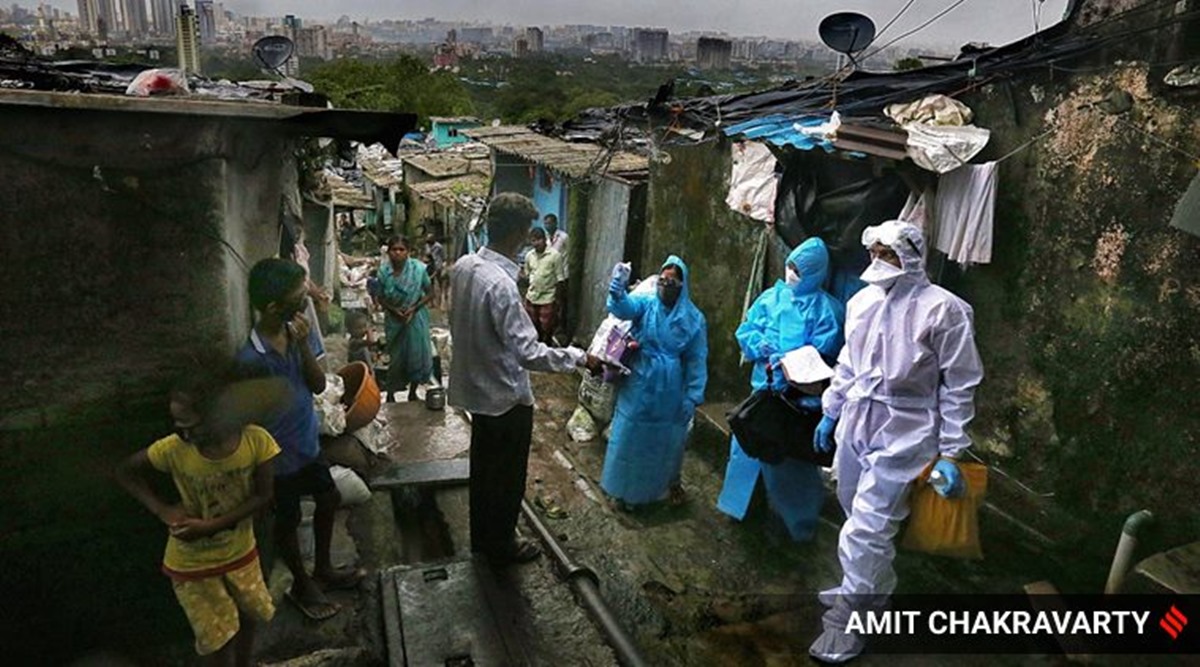 The Brihanmumbai Municipal Corporation’s (BMC) second round of survey covered 5,384 people in three wards – Matunga (F North), Dahisar (R North) and Chembur (M West). (File)
The Brihanmumbai Municipal Corporation’s (BMC) second round of survey covered 5,384 people in three wards – Matunga (F North), Dahisar (R North) and Chembur (M West). (File)A second sero survey conducted in Mumbai mid-August has found that 45 per cent of the people in slums and 18 per cent in non-slum pockets were exposed to Covid-19. The latest findings are different from the first survey in July, when 57 per cent of the people in slums were found to have been exposed to the virus.
Members of the team that conducted the survey attributed the decline in sero prevalence – number of persons in a population who test positive for a specific disease – in slum areas to the fact that an entirely different set of people was surveyed the second time.
But epidemiologists pointed towards the possibility of “antibody decay” in the slum population for the decline in sero prevalence. Several slums had recorded massive number of Covid-19 cases in April. The latest findings for the city are similar to Delhi’s third sero survey, which had also shown a fall in sero prevalence.
Dr Lalit Kant, former head of epidemiology and communicable diseases division of the Indian Council of Medical Research (ICMR), said: “There could be a couple of explanations for this fall. It is possible the second survey was conducted in areas where there were fewer Covid-19 cases as compared to the locality selected in the first survey, hence the varied results. A second possibility is that the infection came to these slum pockets in March-April and five months later, the antibodies have started decaying in the people who were exposed.”
The Brihanmumbai Municipal Corporation’s (BMC) second round of survey covered 5,384 people in three wards – Matunga (F North), Dahisar (R North) and Chembur (M West). These are the same wards in which the first survey was conducted on 6,936 people people in July.
Chembur was selected for medium growth rate of Covid-19 cases, Dahisar had the lowest growth rate and Matunga the highest growth rate in the city.
The first survey had found 57 per cent of people surveyed in slums and 16 per cent in non-slum areas having antibodies against the virus. The second survey found a rise in the level of antibodies in non-slums, but a fall in slums.
As was the case in the first sero survey, more women were found exposed to and had antibodies against Covid-19 than men. “Sero prevalence in women over 40 years of age was slightly higher,” said Suresh Kakani, BMC additional municipal commissioner.
He added that the findings for non-slum pockets, where sero prevalence grew from 16 per cent in the July survey to 18 per cent in the August survey, is “as per estimation”. The decline in sero prevalence in slums, however, “could be because a different population was surveyed”. “This shows the infectivity in slums is reducing,” Kakani said.
A member of the research team said in the second sero survey, for non-slum areas, the same locality was selected as in the first survey. For slums, they opted for a different locality in the same ward. Around one to two per cent of the samples belonged to people who had participated in both the surveys. That could also explain varying results in exposure levels in slum areas between the two survey rounds.
Of the 728 healthcare workers surveyed in slums in this second round, 27 per cent had developed antibodies against Covid-19. BMC officials said the lower rate of exposure in healthcare workers as compared to the rest of the slums is due to better prevention methods adopted by them.
Dr Jayanthi Shastri, head of microbiology at BYL Nair hospital, and a part of the survey team, said: “The two sero surveys show that the level of sero prevalence is different from one locality to another even within the city.”
She added that they are studying antibody levels of people surveyed in the first round to measure neutralising antibodies. “But the process is underway and it will take some time for us to get the results,” Shastri said.
Professor Ullas Kolthur, assistant professor from Tata Institute of Fundament Research, who led the August survey, said: “The findings are important for public discussion and policy decisions. The sample size of the survey is statistically sound as we tried to get an overall representation.”
He added that the results from both rounds of show how antibodies pan over time, and are consistent with emerging evidence from other studies. “We are conducting more statistical analysis to understand antibodies and their prevalence using other tests. We know that antibodies are declining but at what rate we don’t know,” he said
📣 The Indian Express is now on Telegram. Click here to join our channel (@indianexpress) and stay updated with the latest headlines
For all the latest Mumbai News, download Indian Express App.